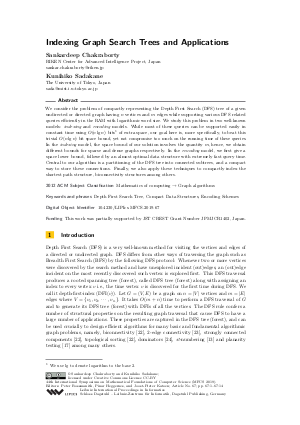Indexing Graph Search Trees and Applications
Authors Sankardeep Chakraborty, Kunihiko Sadakane
-
Part of:
Volume:
44th International Symposium on Mathematical Foundations of Computer Science (MFCS 2019)
Part of: Series: Leibniz International Proceedings in Informatics (LIPIcs)
Part of: Conference: Mathematical Foundations of Computer Science (MFCS) - License:
 Creative Commons Attribution 3.0 Unported license
Creative Commons Attribution 3.0 Unported license
- Publication Date: 2019-08-20
File

PDF
LIPIcs.MFCS.2019.67.pdf
- Filesize: 450 kB
- 14 pages
Document Identifiers
Subject Classification
ACM Subject Classification
- Mathematics of computing → Graph algorithms
Keywords
- Depth First Search Tree
- Compact Data Structures
- Encoding Schemes
Metrics
- Access Statistics
-
Total Accesses (updated on a weekly basis)
0PDF Downloads0Metadata Views
Abstract
We consider the problem of compactly representing the Depth First Search (DFS) tree of a given undirected or directed graph having n vertices and m edges while supporting various DFS related queries efficiently in the RAM with logarithmic word size. We study this problem in two well-known models: indexing and encoding models. While most of these queries can be supported easily in constant time using O(n lg n) bits of extra space, our goal here is, more specifically, to beat this trivial O(n lg n) bit space bound, yet not compromise too much on the running time of these queries. In the indexing model, the space bound of our solution involves the quantity m, hence, we obtain different bounds for sparse and dense graphs respectively. In the encoding model, we first give a space lower bound, followed by an almost optimal data structure with extremely fast query time. Central to our algorithm is a partitioning of the DFS tree into connected subtrees, and a compact way to store these connections. Finally, we also apply these techniques to compactly index the shortest path structure, biconnectivity structures among others.
Cite As Get BibTex
Sankardeep Chakraborty and Kunihiko Sadakane. Indexing Graph Search Trees and Applications. In 44th International Symposium on Mathematical Foundations of Computer Science (MFCS 2019). Leibniz International Proceedings in Informatics (LIPIcs), Volume 138, pp. 67:1-67:14, Schloss Dagstuhl – Leibniz-Zentrum für Informatik (2019)
https://doi.org/10.4230/LIPIcs.MFCS.2019.67
BibTex
@InProceedings{chakraborty_et_al:LIPIcs.MFCS.2019.67,
author = {Chakraborty, Sankardeep and Sadakane, Kunihiko},
title = {{Indexing Graph Search Trees and Applications}},
booktitle = {44th International Symposium on Mathematical Foundations of Computer Science (MFCS 2019)},
pages = {67:1--67:14},
series = {Leibniz International Proceedings in Informatics (LIPIcs)},
ISBN = {978-3-95977-117-7},
ISSN = {1868-8969},
year = {2019},
volume = {138},
editor = {Rossmanith, Peter and Heggernes, Pinar and Katoen, Joost-Pieter},
publisher = {Schloss Dagstuhl -- Leibniz-Zentrum f{\"u}r Informatik},
address = {Dagstuhl, Germany},
URL = {https://drops.dagstuhl.de/entities/document/10.4230/LIPIcs.MFCS.2019.67},
URN = {urn:nbn:de:0030-drops-110112},
doi = {10.4230/LIPIcs.MFCS.2019.67},
annote = {Keywords: Depth First Search Tree, Compact Data Structures, Encoding Schemes}
}
Author Details
Funding
This work was partially supported by JST CREST Grant Number JPMJCR1402, Japan.
References
-
H. Acan, S. Chakraborty, S. Jo, and S. R. Satti. Succinct Data Structures for Families of Interval Graphs. In WADS, 2019.

-
N. Banerjee, S. Chakraborty, V. Raman, and S. R. Satti. Space Efficient Linear Time Algorithms for BFS, DFS and Applications. Theory of Computing Systems, 2018.

-
J. Barbay, L. C. Aleardi, M. He, and J. I. Munro. Succinct Representation of Labeled Graphs. In 18th ISAAC, pages 316-328, 2007.

- M. A. Bender and M. Farach-Colton. The Level Ancestor Problem simplified. Theor. Comput. Sci., 321(1):5-12, 2004. URL: https://doi.org/10.1016/j.tcs.2003.05.002.
-
D. K. Blandford, G. E. Blelloch, and I. A. Kash. Compact representations of separable graphs. In 14th SODA, pages 679-688, 2003.

-
S. Chakraborty. Space Efficient Graph Algorithms. PhD thesis. The Institute of Mathematical Sciences, HBNI, India, 2018.

- S. Chakraborty, S. Jo, and S. R. Satti. Improved Space-efficient Linear Time Algorithms for Some Classical Graph Problems. CoRR, abs/1712.03349, 2017. URL: http://arxiv.org/abs/1712.03349.
-
S. Chakraborty, A. Mukherjee, V. Raman, and S. R. Satti. A Framework for In-place Graph Algorithms. In 26th ESA, pages 13:1-13:16, 2018.

-
S. Chakraborty, V. Raman, and S. R. Satti. Biconnectivity, st-numbering and other applications of DFS using O(n) bits. J. Comput. Syst. Sci., 90:63-79, 2017.

-
S. Chakraborty and S. R. Satti. Space-efficient algorithms for maximum cardinality search, its applications, and variants of BFS. J. Comb. Optim., 37(2):465-481, 2019.

-
D. Clark. Compact Pat Trees. PhD thesis. University of Waterloo, Canada, 1996.

- T. H. Cormen, C. E. Leiserson, R. L. Rivest, and C. Stein. Introduction to Algorithms (3. ed.). MIT Press, 2009. URL: http://mitpress.mit.edu/books/introduction-algorithms.
-
S. Even and R. E. Tarjan. Computing an st -Numbering. Theor. Comput. Sci., 2(3):339-344, 1976.

-
A. Farzan and J. I. Munro. Succinct representation of dynamic trees. Theor. Comput. Sci., 412(24):2668-2678, 2011.

-
A. Farzan and J. I. Munro. A Uniform Paradigm to Succinctly Encode Various Families of Trees. Algorithmica, 68(1):16-40, 2014.

-
L. Ferres, J. F. Sepúlveda, T. Gagie, M. He, and G. Navarro. Fast and Compact Planar Embeddings. In 15th WADS, pages 385-396, 2017.

-
J. E. Hopcroft and R. E. Tarjan. Efficient Planarity Testing. J. ACM, 21(4):549-568, 1974.

- J. I. Munro and P. K. Nicholson. Compressed Representations of Graphs. In Encyclopedia of Algorithms, pages 382-386. Springer, 2016. URL: https://doi.org/10.1007/978-1-4939-2864-4_646.
-
J. I. Munro, R. Raman, V. Raman, and S. S. Rao. Succinct representations of permutations and functions. Theor. Comput. Sci., 438:74-88, 2012.

-
J. I. Munro and V. Raman. Succinct Representation of Balanced Parentheses and Static Trees. SIAM J. Comput., 31(3):762-776, 2001.

- G. Navarro. Compact Data Structures - A Practical Approach. Cambridge University Press, 2016. URL: http://www.cambridge.org/de/academic/subjects/computer-science/algorithmics-complexity-computer-algebra-and-computational-g/compact-data-structures-practical-approach?format=HB.
-
R. E. Tarjan. Depth-First Search and Linear Graph Algorithms. SIAM J. Comput., 1(2):146-160, 1972.

-
R. E. Tarjan. A Note on Finding the Bridges of a Graph. Information Processing Letters, 2(6):160-161, 1974.

-
R. E. Tarjan. Finding Dominators in Directed Graphs. SIAM J. Comput., 3(1):62-89, 1974.

-
K. Yamanaka and S. Nakano. A compact encoding of plane triangulations with efficient query supports. Inf. Process. Lett., 110(18-19):803-809, 2010.

